Don Revie signed Jim Storrie for
Leeds United in June 1962 as a foil for the returning Welsh superstar
John Charles. When it became clear that the
Charles experiment was a dismal failure, it was Storrie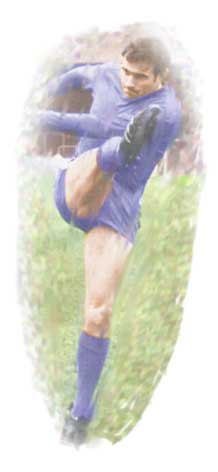 who provided the solution to United's goalscoring difficulties. The bustling
Scot repaid his £15,650 fee tenfold as he led the West Yorkshire club
back to the First Division and beyond.
who provided the solution to United's goalscoring difficulties. The bustling
Scot repaid his £15,650 fee tenfold as he led the West Yorkshire club
back to the First Division and beyond.
Diamond Jim Storrie was one of the shorter centre-forwards in the British
game - he was less than five feet nine - and never looked the most composed
or accomplished of footballers. He made up for his shortcomings with a
hard running style that unsettled defenders, creating goalscoring opportunities
for himself and his colleagues.
He was a very popular guy with players and fans alike for his genial
good humour and fondness for a laugh.
The young Scottish starlet Eddie Gray was the butt of Storrie's humour
on more than one occasion. Gray: 'One of my most embarrassing experiences
at Leeds was when, at fifteen or sixteen, I was in Bobby
Collins' team for pre-season training. As I was regarded as one of
the best runners at the club, Bobby felt that victory for the team in
the cross-country race was virtually a foregone conclusion. The only threat
came from Jim Storrie … Sure enough, half a mile from the end, Jim and
I were at the front; it was between him and me. I felt I had loads of
power in reserve but as I was thinking of unleashing it, Jim said, "Eddie,
we don't need to race. If we stay together, we will both get ten points."
I fell for it hook, line and sinker - how naïve can you get? About 100
yards from the line, Jim, a real character with a tremendous sense of
humour, sprinted flat out to win.'
On another occasion, Storrie good naturedly chided the inexperienced
Gray, 'I hear you've been saying that it won't be long before you're in
the team.'
Jim Storrie was a wonderful clubman, who played a major part in Leeds
United's rise to fame under Don Revie and adapted admirably to the target
man role. Defenders were never able to relax when the thick set Scot was
around. He was prepared to go in where it hurt and tell defenders where
to get off.
Two United fans recall Storrie for the Leedsfans.org.uk website:
Alan Farrar: 'He never quit and gave everything. I have a vague memory
of him crashing heavily into the goal posts at Blackpool in the early
Sixties while trying to get on the end of a cross.'
Mike Gill: 'Anybody remember an away game in 1965/66
when Jim baited Adam Blacklaw, the Burnley keeper, throughout the match?
How they both weren't sent off I don't know. But they both went off with
their arms around each other … Different days.'
Leeds fans have always appreciated the willing trier and Storrie won
himself a fan club on the Lowfields for his sterling performances. One
minute he would be converting the most difficult of chances and the next
he would be missing the biggest sitter in the world. But he was adored
by the fans for the effort he put in at a crucial time in the club's history.
Members of waccoe.com remembered him this way:
back to top
'Storrie chased down almost every back pass to the keeper no matter how
much of a lost cause it was and where he had to run from to do it.'
'He was such a frustrating player to watch at times, the only way to
relieve the stress 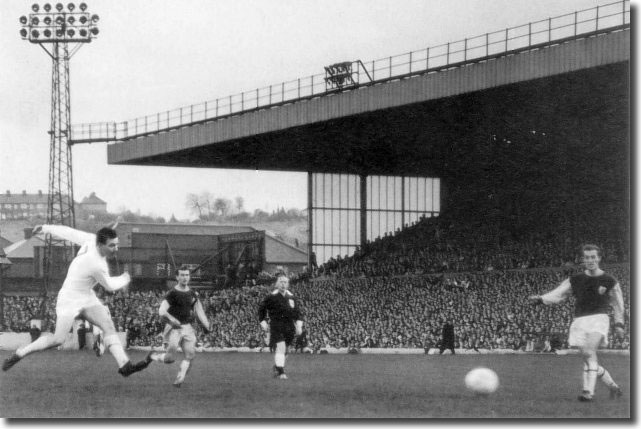 was
to count the goals he scored, not the many, many misses.'
was
to count the goals he scored, not the many, many misses.'
'The biggest plus about Diamond Jim was that he played with a big smile
on his face, without malice and ALWAYS played for the shirt. More technically
gifted players have been both before and since but no Leeds fan can ask
for more than what he gave us.'
'One memory I have is of a West Riding Cup game against Halifax when
I seem to remember Jim missing 10 to 15 pretty easy chances. One of these
chances he was stood very near the goal line, certainly inside the goal
area, and still managed to get it up and over the bar.'
'Another Storrie moment was in front of the Scratching Shed (against
Burnley in October 1965). Jim beat the left-back and came in on the byline.
The keeper expected him to cross, their defence expected him to cross,
our other strikers expected him to cross. Perhaps even Jim himself expected
to cross it - instead of which he absolutely hammered it inside the keeper
and in off the back post and then he turned round and trotted back to
the half way line as if it were the most natural thing in the world.'
Tony Hill: 'I would call Diamond Jim splay-footed and often wondered
at his ability to beat a defender, they were probably mesmerised by his
feet! He was also the first player I saw do the trick of centring with
any force by bringing one foot behind the other to deliver the cross,
something that Harry Kewell later did quite often, although with his left
as opposed to Storrie's right. Many happy memories of the "Pillock
from Kirkintilloch" as a friend of mine used to endearingly call
him, jokingly rather than with malice.'
Jim Storrie was born on 31 March 1940 in Kirkintilloch, Dunbartonshire,
in the West of Scotland. He became well known locally with nursery outfit
Kilsyth Rangers, one of the most successful junior clubs of the 1950s,
and attracted the interest of First Division club Airdrieonians. In December
1957 Storrie signed for them as a part timer.
At an early age, Jim married local girl Nancy, whose father, Tony Weldon,
played for Airdrie, Everton, Hull, West Ham, Lovells Athletic and Rochdale.
His debut for Kilsyth came in a friendly at Doncaster on 15 February
1958. He was allowed to come on as a substitute at half time after an
Airdrie player suffered a broken nose during the first half. He scored
the third goal in a 3-3 draw. Storrie's first start came in a Lanarkshire
Cup tie at home to Albion Rovers on 7 April, when he scored in a 3-1 win
and he made his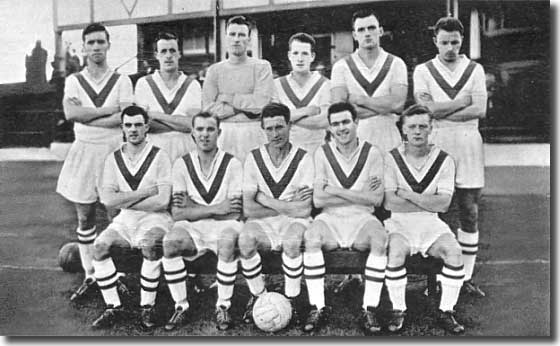 League debut away to Third Lanark. Airdrie lost 3-1 and finished the season
16th out of 18.
League debut away to Third Lanark. Airdrie lost 3-1 and finished the season
16th out of 18.
Storrie established himself in the first-team thereafter and built a
decent reputation, scoring 48 goals in 89 appearances over the next four
and a half years. The Diamonds climbed to a hugely impressive fifth spot
in 1959, before finishing 16th again the following year.
In 1961 they made it to the Scottish Cup semi-final where Celtic thrashed
them 4-0.
Storrie's performances brought him to the attention of Leeds United's
Scottish scouts, who recommended him to the club's young player manager,
Don Revie.
back to top
Leeds were struggling against relegation from the Second Division at
the time (the winter of 1961/62)
and when Revie made his initial approach, Storrie was not terribly impressed.
He said later: 'The first time Don came for me, I virtually turned him
down out of hand. I didn't fancy Leeds at all at first ... I thought they
were heading for the Third Division.'
Revie was desperately seeking recruits to help dig United out of a hole
and by transfer deadline day he had signed Burnley reserve forward Ian
Lawson, along with veteran Sheffield United full-back Cliff Mason
and Everton's former Scottish international schemer Bobby Collins.
Revie's transfer market dealing paid off and United secured their survival
with a decent unbeaten run. Buoyed by survival and a transfer kitty, Revie
set out to build a new team, ditching players like Billy McAdams, Derek
Mayers, Peter McConnell and Bobby Cameron. Undeterred by Storrie's earlier
rejection, Revie chanced his arm again. This time he was successful, partly
due to the signing of Collins and the promise of John Charles' imminent
arrival. The overriding factor, though, was Revie himself, with his high
ambition and persuasiveness.
Storrie: 'Don Revie and Harry Reynolds came up to our house. My wife
said I was at work, so they came to the works. They were very persuasive.
I listened to what (Revie) had to say and was immediately impressed by
his sincerity. He laid his cards on the table. I remember his telling
me: "The sky's the limit - we're going to be like Real Madrid."
Well, I did feel that was a bit ludicrous; Leeds weren't even the best
team in Yorkshire then.
'I had no particular desire to go to Leeds because they were in the Second
Division but Revie told me they had got Bobby Collins and John Charles
and all of a sudden the package looked pretty impressive.'
Revie earned a reputation in the early Sixties for getting his man, whether
it was a much sought after schoolboy international, such as Eddie Gray
and Peter Lorimer, or a seasoned professional, like Collins and Charles.
His silver tongue and persistence did the trick on Storrie.
The 22-year-old Scot signed for United on 19 June 1962, and John Charles
followed suit shortly afterwards for a club record £53,000. The United
approach and training methods came as a shock to both men, as recalled
by Storrie: 'When I joined Leeds, it was like going into a different world.
I found them so much more professional than clubs in Scotland - everything
was so well-organised that it made you WANT to work hard at your game.
One cannot help getting caught up in an atmosphere like this. All managers
like to think that their players are prepared to run through a brick wall
for them, but this was true as far as Don was concerned. He treated us
as men, as individuals.
'His attention to detail is remarkable: one morning I happened to mention
that my son wasn't well, and he immediately arranged for the club doctor
to give him a thorough check-up. He knew that if I was going on to the
field worrying about my little fellow, I couldn't give of my best. All
this might seem trivial to outsiders, but you'd be surprised how much
these little kindnesses help to establish a good team spirit and player-manager
relationship.'
As remembered by Storrie, Charles was not as receptive to his new surroundings.
'John just didn't fancy it at Leeds when he came back from Italy. He and
Les Cocker didn't get on. He wouldn't train as rigorously as they wanted
- in Italy he was used to flicking the ball about and wandering 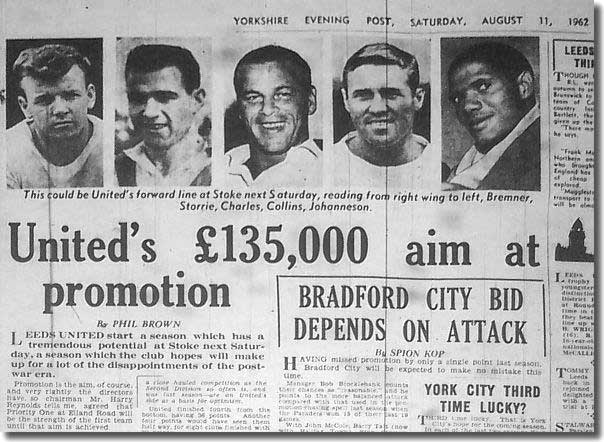 about
the park. Italian teams don't train as hard as those in England, and Charles
did not possess sufficient speed and stamina for league football in this
country.
about
the park. Italian teams don't train as hard as those in England, and Charles
did not possess sufficient speed and stamina for league football in this
country.
'In this respect, I will always remember a match he played at Huddersfield.
They cleared the ball upfield following a Leeds attack, and our forwards
made their way back into covering positions. After about ten seconds,
the ball was booted into Huddersfield's area again - and John was still
struggling up to the halfway line. He and Huddersfield's goalkeeper were
the only players in that half of the field!
'We were a very physical, hard working and hard running side. It was
high-pressure football. We put the opposition's players under pressure
all over the park. We harassed and chased. Revie was one of the first
managers to introduce that way of playing. I was a forward and my first
job was to defend. That was the mentality. John was like a duck out of
water playing that way. Had he been younger he might have adapted. He
wanted to play one touch football and flick the ball here and there. At
the time that wasn't Leeds' style. Long balls were played to the corner
flag and John was expected to chase after them. At half-time in one game,
I remember John saying, "I'm not running my pants off for long balls."
And wee Billy Bremner said, "You're making that f***ing obvious!"'
back to top
Charles and Storrie were signed to address United's problems in front
of goal. Billy Bremner had top scored with 11 as the Peacocks managed
just 50 goals in 1961/62. Revie had tried six different players at No
9, including big Jack Charlton and even himself.
The two recruits appeared together in the August 1962 opener at Stoke
City, in a side that included Bremner, Charlton, Tommy Younger, Grenville
Hair and Albert Johanneson.
Storrie: 'On the eve of my first match for Leeds I was wandering around
the hotel looking for the other players, and bumped into Don in the foyer.
"If you're looking for the other lads, they're in the bar,"
he said. "Go in and have a drink son." I thought he was trying
me out to see whether I drank; you know, managers in Scotland frowned
on that sort of thing. But sure enough, they were in the bar, knocking
back beer. Don trusted his players not to overdo it - his attitude was:
"If they want to drink, I prefer them to do it in front of me rather
than behind my back."'
While the headlines before the game were all about the Welshman, it was
Jim Storrie who earned the plaudits, netting the only goal of the game
five minutes before the interval to get United off to a winning start.
He had a storming match and capped it with his score, a rising drive from
ten yards.
Storrie settled in quickly at Elland Road, helped by the presence of
a number of countrymen,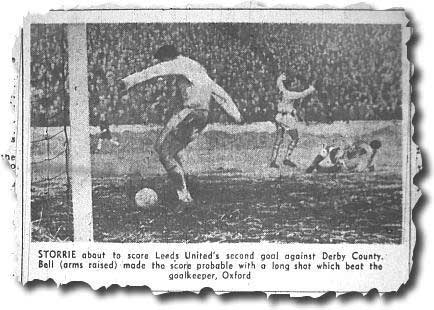 including Collins, Bremner, Younger, Eric Smith and Tommy Henderson. He
featured again during the week in the second match, at Elland Road against
Rotherham United.
including Collins, Bremner, Younger, Eric Smith and Tommy Henderson. He
featured again during the week in the second match, at Elland Road against
Rotherham United.
Leeds were three goals behind after 50 minutes and treading water desperately
as Don Weston led their defence a merry dance.
Then Storrie headed home a Bremner free kick to give some hope of a revival.
An Albert Johanneson penalty brought a second and then Charles played
a one-two with Storrie on the edge of the Rotherham box before driving
home the equaliser. The move was about the only example of Storrie and
Charles clicking as a partnership in their time together. The Millers
were not to be denied and got a winner ten minutes from the end of a gripping
struggle.
It quickly became painfully apparent that John Charles had made a big
mistake in returning to Elland Road, and after just three goals in eleven
appearances he was on his way back to Italy. Don Revie used some of the
£70,000 fee to buy the fleet-footed Don Weston, who had made United's
life so difficult against Rotherham.
Weston and Storrie formed a twin spearhead for most of the season as
United recovered from a mediocre opening to launch a promotion challenge.
Weston never lived up to the sparkling promise of his debut day hat trick
against Stoke City in December, and Storrie carried the attacking burden
for most of the season, as recalled by Norman Hunter:
'The youngsters … had repaid the faith [Revie] had shown in them and
his signings had played their parts to the full, none more so than Jim
Storrie. He had the goalscoring knack although the ball didn't always
go in off his head or his boots. It would fly in off his knees, his thighs,
almost any part of his body - but in it went, which was the main thing.
During that 1962/63 season, Jim netted 25 goals in 38 league appearances.'
Hunter had good reason to remember Storrie fondly, for it was partly
down to the Scot that he was converted from an inside-forward to earn
himself a world wide reputation as a tough tackling defender: 'I was playing
for the juniors when Revie took me to one side for a chat. He told me
that Jim Storrie had remarked what an awkward "so and so" I
was to play against. Apparently, Jim had told the Gaffer that every time
he played against me I always managed to get the ball off him and that
I seemed to be able to get a foot in and do this, that and the other and
come away with the ball.'
If Storrie was an outstanding success as a target man that season, he
wasn't altogether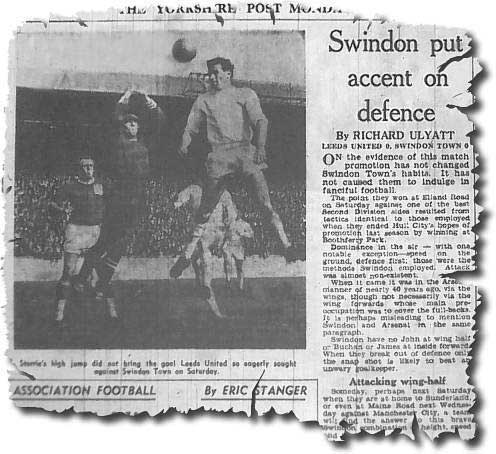 enamoured with the role, as he recalled later: 'Really, I was an old fashioned
inside-forward carrying the ball through, playing one-twos. In Scotland,
no one bothered how you played and I always seemed to be looking for people
to play off. But when I was the target man, I had the goalkeeper behind
me. Individually, I think I became a worse player. My wife Nancy told
Revie this at a function one night, but he just laughed and said, "you
may be right but they are a very successful team." That was true.
The success glossed over a million deficiencies. I adapted because I was
caught up in all the enthusiasm.'
enamoured with the role, as he recalled later: 'Really, I was an old fashioned
inside-forward carrying the ball through, playing one-twos. In Scotland,
no one bothered how you played and I always seemed to be looking for people
to play off. But when I was the target man, I had the goalkeeper behind
me. Individually, I think I became a worse player. My wife Nancy told
Revie this at a function one night, but he just laughed and said, "you
may be right but they are a very successful team." That was true.
The success glossed over a million deficiencies. I adapted because I was
caught up in all the enthusiasm.'
In fact, so engaged was Storrie with the Leeds cause that he even went
in goal for an injured Gary Sprake, after he was injured at home to Portsmouth
in December. He wasn't an outstanding success, succeeding a goal in the
five-minute spell he served between the sticks.
back to top
Storrie netted hat tricks against Plymouth and Cardiff and, after two
more in a 3-0 win against Luton at the beginning of May, Eric Stanger
remarked in the Yorkshire Post, ;Storrie's two goals would have
graced any game. There is no doubt that Storrie is becoming one of the
most dangerous leaders in the Football League. From the way in which he
worries the opposition, seeks to exploit the slimmest of chances and bangs
away at goal at every opportunity, he reminds me more and more of that
other Scot of yesteryear who got so many goals for Leeds - Tom Jennings.'
Ultimately, United's promotion chase was unsuccessful, but they had a
memorable season, building the foundations for the success of the next
decade, as recalled by Storrie.
'We were a ball-winning side, free of injuries, and champing at the bit
to go. We played a method game, high-pressure football. Bobby Collins
would get hold of the ball and spray passes all over the park for people
to chase after. The forwards would hustle, cutting off the supply of back
passes to the goalkeeper. I reckon we scored about 10-15 goals a season
through forced errors that way.'
United finally achieved the promotion
that Revie sought in 1964, though Storrie only enjoyed a cameo role,
with 3 goals in 15 Second Division appearances.
Storrie: 'I scored quite a few goals the first season I was there, but
the next season hit a bad patch. It seemed the harder I tried to get out
of it, the worse it became. Don called me into his office and told me
he appreciated my problem and would support me to the hilt. 'Get your
wife and kiddie and have a fortnight's holiday in Scotland,' he said.
'You can do anything you like - as long as it's not connected with football.'
When I came back, I would have done anything for him. He was never too
busy to spare a few minutes asking you how the wife and family were. Most
managers do it out of politeness, they don't really mean it. But with
Don, you felt he really was interested.'
As well as a loss of form, Storrie had a lengthy lay off with damaged
knee ligaments. He was carried off during an ill-tempered Christmas confrontation
with promotion rivals Sunderland and missed the rest of the season, playing
just two more games. Storrie recalls the spiteful clash at Roker: 'Johnny
Crossan was antagonising Billy Bremner from the beginning, but both were
having a dunk at each other off the ball. Crossan said, 'You're mad, you
Leeds.' When I was carried off, the fans were spitting at me. But Bobby
Collins went out and sought retribution - later Len Ashurst was carried
off, too.' Storrie had only just returned to the team after injuring an
ankle against Norwich at the end of September.
Deprived of his first choice centre-forward, Don Revie signed Middlesbrough's
former England front man Alan Peacock to give
a fillip to United's promotion challenge. The move was a success and Leeds
outdistanced Sunderland and Preston to win the title, returning to the
First Division after a four-year absence.
Jim Storrie returned fully fit at the start of the 1964/65
campaign and was a mainstay as United came close to a League and Cup double.
The Scot top scored with 16 goals in 37 league games, managing another
couple on the way to the Wembley Cup final.
It was feared that Storrie had broken his leg during a 4-0 defeat at
Blackpool in September, but the fears proved groundless. An X ray showed
that he had merely trapped a nerve and sustained a bad bruise.
back to top
The Leeds way unsettled sophisticated First Division opponents, as remembered
by Storrie. 'Revie used to say: "Anyone who beats you at home must
know 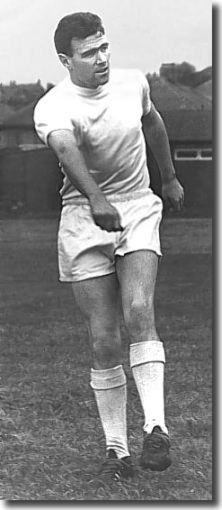 they've
been in a game." We tended to take this a bit too literally; it became
an offence for an opponent to encroach our eighteen-yard line! I think
we were over-exuberant more than anything. But Revie must take part of
the blame because when we were getting all that bad publicity, he told
us: "Don't worry about the press ... what matters is the fact that
they are talking about you." I am sure he later regretted this attitude.'
they've
been in a game." We tended to take this a bit too literally; it became
an offence for an opponent to encroach our eighteen-yard line! I think
we were over-exuberant more than anything. But Revie must take part of
the blame because when we were getting all that bad publicity, he told
us: "Don't worry about the press ... what matters is the fact that
they are talking about you." I am sure he later regretted this attitude.'
Andrew Mourant: 'Jim Storrie recalls how Revie's ambition and enthusiasm
infected the players. "After winning promotion, most managers would
talk in terms of consolidation. He spoke in terms of finishing in the
top four. He said, 'We will come up against some world class players but
we will be the best team in the league.' So he had the optimists among
the lads thinking we would win the League and even the pessimists thought
we might finish halfway up."
'The club had never before been run as Revie ran it. He was the most
driven manager in Leeds United's history. At the outset, he set impossible
targets for the squad, of whom only a handful had First Division experience.
The psychology was unsophisticated but effective.
'Victories in the first three games … gave Leeds more confidence than
could ever have come from Revie's words alone. They badly needed the points
as injuries to Bell, Giles and Weston, and the
prolonged absence of Alan Peacock caused their form to falter. They lost
four of the next eight games. The striker's burden was once more thrust
upon Jim Storrie: Leeds had not taken the opportunity to strengthen the
squad during the close season.
'By mid-April, as Chelsea's form wavered, the title became a two horse
race involving the Uniteds of Leeds and Manchester. The Yorkshire team,
which had won nothing save for a couple of Second Division championships,
was on the threshold of winning the League and Cup double, a far cry from
their Second Division days. On 17 April, 52,368 people packed Elland Road
for the most momentous League match in Leeds' history. But with Bremner
replacing the injured Storrie at inside-right and Jimmy
Greenhoff drafted in at Number 4, Leeds' swaggering home form (four
successive wins with 14 goals scored) deserted them when it mattered most.
'For Jim Storrie, watching in the stand, the frustration was enormous.
"We lost 1-0 to a daisy cutter from outside the box. It was a dour
game but enough to give Manchester the championship," he said. With
four matches and eight points still to play for, the morale of Revie's
men had been shot to pieces, and they still appeared in shock two days
later, losing 3-0 at Sheffield Wednesday. Their
defiance in fighting back from 3-0 down at Birmingham to draw the final
match of the season 3-3 was not enough. Both Uniteds finished with
61 points, but Manchester's goal average was far superior.'
Storrie was recalled from injury to face Liverpool
at Wembley in the final. Bobby Collins recalls that Storrie 'was injured
but never told anybody because he was desperate to play and get a medal.'
United were badly outplayed on the day, with Albert Johanneson a timid
shadow of himself, and Storrie a limping passenger on the flanks. The
Reds won the game 2-1 after extra-time to leave United with nothing to
show for a wonderful campaign.
Storrie: 'At the finish, the Leeds players felt sorrier for Revie than
themselves. We were sitting with our heads bowed when he came into the
dressing room, and someone said: "We're sorry boss ..." He replied:
"You've run your guts out all season, have nothing to show for it,
and you're sorry for ME? Don't be so bloody daft. Get 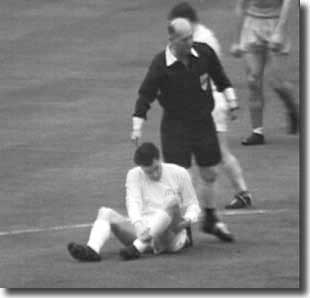 dressed,
we're going back to the hotel for a booze up."'
dressed,
we're going back to the hotel for a booze up."'
Whether it was simply due to a loss of form, or a case of Revie feeling
that Storrie had let him down by not coming clean about his injury, the
Scot was never quite the same player for Leeds again. In 1965/66
he managed 13 goals in 30 league games and featured in 9 Inter Cities
Fairs Cup-ties, but spent most of the season consigned to the wings, out
of sorts and out of position. He was not a natural wide man and it showed.
As Eric Stanger observed after a home defeat to Liverpool in December,
'Storrie tries hard on the right wing but that will never be his best
position.' He would often beat three or four men out wide but then spoon
his cross out of play.
It was something of a mystery that Revie persisted with Storrie as a
winger, but he had few alternatives with Johnny Giles moving inside to
replace Bobby Collins when the Scottish
veteran broke a thigh. Storrie had a thankless task, but played his
part with courage and tenacity.
back to top
After the injury prone Alan Peacock broke down once more at the end of
January, Storrie led the United attack through the last months of the
season. Storrie's play and the team's results improved but they were outplayed
and beaten in a Fairs Cup semi-final against Spain's Real Zaragoza.
Storrie put his apparent loss of form down to the Giles-Collins switch:
'My game was based on speed off the mark - the ability to lose a defender
for a split second or so. Bobby's style of play suited me because as I
ran into an open space, I knew he would immediately put the ball into
my path, no matter what position he was in. Johnny, however, liked to
hold the ball more, so I was often caught in two minds, whether to run
forward to receive a pass or move to the side so he could play a one-two
off me.'
Matters came to a head in 1966/67
when Storrie played just six ;eague games, three of them as sub. He was
selected at No 7 in a pre-season friendly against a Glasgow Select XI,
but was then consigned to the bench for most of the year, having to wait
until October for a rare League start.
Disheartened by the course of events, Storrie requested a transfer at
the beginning of November in the hope of first-eam football elsewhere.
In February 1967, he got his wish, returning to Scotland in a £13,500
move to Aberdeen.
He scored one of the goals in a Scottish Cup quarter-final replay against
Hibs as Aberdeen won 3-0, but rather blotted his copybook by missing a
penalty in the semi final against Dundee United. The Dons won the game
1-0 courtesy of an own goal by Tommy Millar before losing 2-0 to all conquering
Celtic in the Hampden final before a crowd of 126,000.
Storrie lost his first-team place in November 1967, despite being the
club's leading scorer. Disillusioned by events, he asked to go on the
transfer list, posting a reminder of his talents with five goals for the
reserves against Partick. Just after Christmas Storrie joined Rotherham
United for £7,000, after turning down moves to 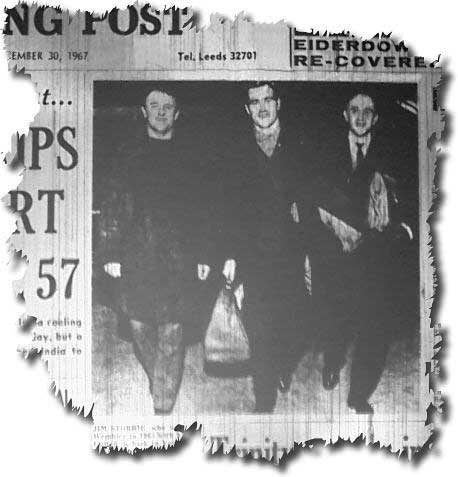 Southend
and Barnsley.
Southend
and Barnsley.
The deal was one of the first completed by new Millers manager Tommy
Docherty. The controversial Scot had built a tremendous young team at
Chelsea, leading them to the 1967 FA Cup final, but resigned in October
after receiving a 28-day suspension following incidents on the club's
summer tour to Bermuda.
Rotherham were rooted at the foot of the Second Division at the time,
but Storrie's debut on 30 December brought a 1-0 win against Preston and
saw the South Yorkshire club climb above Plymouth in the rankings.
They crashed 6-0 at promotion chasing QPR a week later, but then went
nine games unbeaten in the League and enjoyed an exciting FA Cup run.
In the third round, Storrie's 58th minute goal was enough to see off Wolves.
Paul Fitzpatrick in The Guardian: 'Quinn made the pass and Storrie,
who did well to hold off Woodfield, did the rest, the ball rolling home
after striking a post.'
Five minutes from the end of the fourth round tie at Aston Villa, Storrie
scored another famous winner, seeing Rotherham through to the fifth round
for the first time since 1953. The Scot had rediscovered his touch. The
Yorkshire Evening Post reported, following another valuable goal,
the winner against Huddersfield at the beginning of March: 'Storrie had
the last word for it with his brilliantly headed goal which gave Rotherham
both points. A much leaner Storrie than in his Leeds days has now scored
five goals in the last six games.'
The Guardian featured United as they prepared for the fifth round:
'The jaded, sorrowful football backyard which was Millmoor is now a place
where everyone from first team to sweepers up (the brush variety) has
lightness in his step. This is the small, new world of Docherty. Tommy
Docherty, often easy to love and sometimes difficult to disagree with,
is producing a noisy little revolution in South Yorkshire.
'He has been able to restyle and revitalise the entire playing staff.
Established, proven favourites have gone. Other players, some barely old
enough to shave, have come in, some signed on instant decision.
'He has promised - and not lightly - that he will take Rotherham to the
First Division, and to Europe. He qualifies this by saying: "It may
take time." This is doubly delightful to his new admirers in the
coalfields and steel making plants. It smacks of "big man".
'So it is that this week a new style of football dictator holds often
hilarious court in his pre Cup tie hotel at Scarborough, races his men
across the unwelcoming sands before breakfast, out talks the interviewers,
chuckles at adversity, and beams happily upon man and creature around
him. Tommy Docherty was never happier - you have his word for it.
back to top
'A United side with average ago of just over 20 is in step now with the
courage and ambitious thinking of their manager. The team that accounted
for Wolverhampton Wanderers 1-0 at home, then Aston Villa 1-0 at Villa
Park, take on Leicester City in an all ticket tie at Millmoor.
'The side's line up is based on 4-3-3. Alan Hill, from Barnsley, is in
goal. The back row is formed of Trevor Swift, a crash tackler, at right-back;
Dave Watson, a bargain from Notts County, at centre-half; Brian Tiler,
the captain, who at the age of 24 had more than 200 League games to his
credit; and Neil Hague, and 18-year-old youth international, at left-back.
'John Quinn, the man Docherty bought for £27,000 from Sheffield Wednesday,
joins the outside-forwards, Andrew Wilson (21) and David Bentley (17)
in the middle row. Jim Storrie, a former Leeds 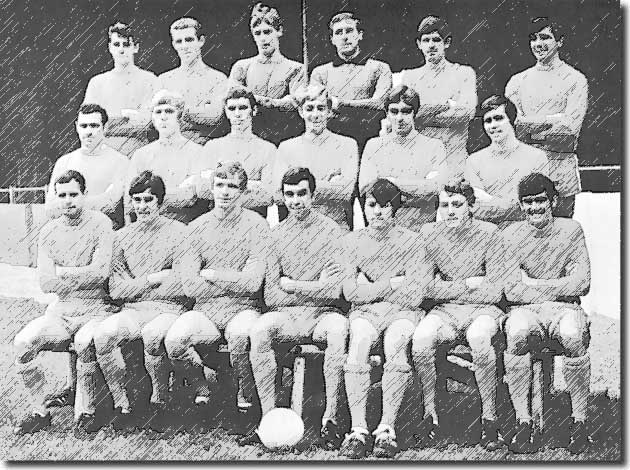 United
player, operates just behind the rest of the front row. Like Quinn, Storrie
has known Wembley as a member of the losing side. His goals defeated Wolverhampton
and Aston Villa, yet he cost Docherty only £7,000 from Aberdeen. He has
scored five goals in his last six matches.
United
player, operates just behind the rest of the front row. Like Quinn, Storrie
has known Wembley as a member of the losing side. His goals defeated Wolverhampton
and Aston Villa, yet he cost Docherty only £7,000 from Aberdeen. He has
scored five goals in his last six matches.
'In front will be John Shepherd (21), a local player who is unpredictable
but sometimes exceptional, and 18-year-old Stephen Downes. Downes, says
Docherty, has a remarkable flair for goals. In two and a half senior matches
he has scored once and created two other goals. He has scored 27 times
for the reserves.'
It was the self same Dave Watson who later went on to play for Manchester
City and England. Also in the Rotherham ranks at the time was 'a bustling
though none too quick wide midfielder', the young Neil Warnock.
The Millers fought back from a poor opening against Leicester - they
could have been three goals down in the first 20 minutes, though only
a twice taken penalty by David Nish gave the Foxes a slim advantage -
before recovering strongly to lay siege to the Leicester goal for the
final 20 minutes. 'Storrie was a livewire,' wrote Terry Lofthouse in the
Yorkshire Evening Post, while Roderick MacLeod of the Yorkshire
Post recorded: 'Storrie came within inches of scoring and with 40 seconds
left, players beat the ground in frustration as a header from Hague was
on its way into the net when Downes instinctively helped it on, but over
the top, from three yards out.'
In the end, Rotherham got their just reward eleven minutes from time
when Steve Downes angled in a fine equaliser. The Leicester defence was
in ruins and it was only lack of time that prevented a third Cup upset.
The best chance of glory had gone, and even though they forced City to
extra-time at Filbert Street. MacLeod: 'Rotherham did get the ball into
the net after 16 minutes when Downes, tackled by two defenders, headed
down to Tiler. Tiler's shot flashed well wide of Mackleworth, but the
referee gave a free kick against Downes. Storrie had two flying headers
saved by the Leicester reserve goalkeeper and Tiler wasted two chances,
first slicing wide and then ballooning over the top.' Goals by Frank Large
and Mike Stringfellow ended South Yorkshire hopes.
The heady excitement of their Cup run over, Docherty's side returned
to the grim struggle against relegation. Storrie's initial burst had petered
out, with the winner against Huddersfield on 2 March his final goal of
the campaign. Nevertheless, a 1-0 success at Bristol City on 29 March
was United's fourth in a nine-match unbeaten run and took them a point
clear of relegation.
Three successive defeats thereafter brought a sharp dose of reality and
another at Hull on 25 April left Rotherham in need of a miracle, three
points from safety with only two games remaining. Preston beat Portsmouth
3-1 at Deepdale on 11 May to end their own relegation fears, confirming
that Rotherham's battle was over.
Tommy Docherty left Rotherham in October 1968 to take over at QPR. He
was in charge at Loftus Road for just 29 days before becoming the first
manager appointed by Doug Ellis at Aston Villa.
In his absence, Storrie enjoyed a successful 1968/69, 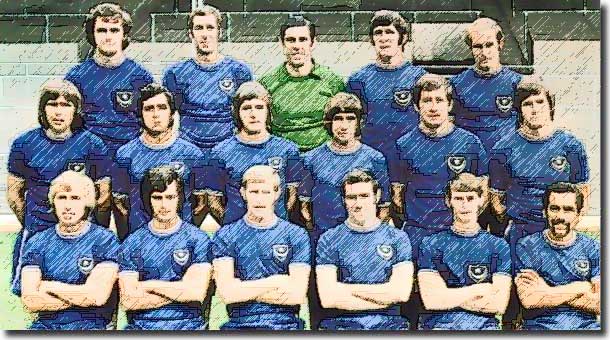 becoming
the leading scorer with 14 league goals, four of them in the final four
games, as Rotherham stabilised in mid table. He switched to inside-right
for the latter stages of the season, using his vast experience to bring
on young Steve Downes.
becoming
the leading scorer with 14 league goals, four of them in the final four
games, as Rotherham stabilised in mid table. He switched to inside-right
for the latter stages of the season, using his vast experience to bring
on young Steve Downes.
back to top
In December 1969 Storrie returned to the Second Division with Portsmouth
in a £5,000 deal, and remained at Fratton Park until October 1972.
He managed 12 goals in 43 games for a team that consistently laboured
in the lower half of the table. He was a fans' favourite fir the effirt
he showed Storrie spent most of his time at Pompey partnering former Burnley
and England striker Ray Pointer or Ray Hiron, but eventually lost his
place to Mike Trebilcock, the Cornishman who famously scored twice for
Everton in the 1966 FA Cup final win over Sheffield Wednesday. The star
of the show, though, was the talented England Under-23 midfielder Norman
Piper.
Storrie's time at Pompey was best remembered for the goal that wasn't.
The moment came as Portsmouth played Leicester at Filbert Street in September
1970. The design of the Foxes' triangular goal stanchions had been criticised
previously - the previous season Aston Villa's Pat McMahon had fired home
only to see his effort rebound off a stanchion and back into play. McMahon's
goal was disallowed by the referee and the decision contributed to Villa's
relegation. A year on Storrie suffered the same fate. Leicester keeper
Peter Shilton told the referee that the ball had crossed the line (different
days, indeed), but the official still wouldn't allow it. Newspaper photos
after the game clearly showed the ball over the line with Shilton looking
straight at it. Pompey lost the game 2-0.
Storrie played 3 matches on loan to Aldershot in March 1972 and was granted
a free transfer by Portsmouth two months later. He joined St Mirren as
player coach at the end of 1972. He later spent a while as player manager
at non-League Waterlooville.
Premier League St Johnstone appointed him manager five games from the
end of the 1975/76 season, with the Saints doomed to relegation. With
nothing to play for, Storrie had some impact - the Saints beat Aberdeen
2-0 and drew another couple of games - but by the end of the season a
poor team had amassed the dismal total of 11 points.
The young manager struggled to arrest the slide the following season
and it required a 4-1 win on the last day of the campaign to prevent a
second successive relegation.
Storrie was responsible for signing the player who was to become the
holder of the club's appearance record, defender Drew Rutherford. Jim
Slater in the Who's Who of St Johnstone 1946-92: 'When manager
Jim Storrie paid only a small fee to East Fife for their young central
defender he did possibly the best piece of transfer business in the club's
history. At the time Jim was no doubt thinking purely in terms of surviving
the 1976/77 season as a First Division outfit. With Drew's enthusiasm
and commitment in the team, we picked up 14 points from the last 14 games
to avoid relegation ... In February 1982, the 5th anniversary of his transfer,
Drew played his 217th match for Saints. In that time he had missed only
5 games.'
Storrie resigned early in 1977/78 after a disappointing goalless draw
against Berwick and later took a job coaching his first club, Airdrie.
He worked at a sports centre in Cumbernauld for 14 years and later at
Stirling University before retiring.
Diamond Jim Storrie pulled up few trees after quitting Elland Road, though
he will always be remembered for helping to transform the fortunes of
Leeds United. Richard Longley from Leedsfans.org.uk: 'To this day
I don't think most people realise just how important a part Jim played
in the foundations of the successes Leeds had in the 60s. He was such
a hard working player and what he lacked in natural skills he more than
made up for in effort and scored many goals and indeed won matches with
his tenacity.'
back to top
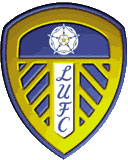










 who provided the solution to United's goalscoring difficulties. The bustling
Scot repaid his £15,650 fee tenfold as he led the West Yorkshire club
back to the First Division and beyond.
who provided the solution to United's goalscoring difficulties. The bustling
Scot repaid his £15,650 fee tenfold as he led the West Yorkshire club
back to the First Division and beyond. was
to count the goals he scored, not the many, many misses.'
was
to count the goals he scored, not the many, many misses.' League debut away to Third Lanark. Airdrie lost 3-1 and finished the season
16th out of 18.
League debut away to Third Lanark. Airdrie lost 3-1 and finished the season
16th out of 18. about
the park. Italian teams don't train as hard as those in England, and Charles
did not possess sufficient speed and stamina for league football in this
country.
about
the park. Italian teams don't train as hard as those in England, and Charles
did not possess sufficient speed and stamina for league football in this
country. including Collins, Bremner, Younger, Eric Smith and Tommy Henderson. He
featured again during the week in the second match, at Elland Road against
Rotherham United.
including Collins, Bremner, Younger, Eric Smith and Tommy Henderson. He
featured again during the week in the second match, at Elland Road against
Rotherham United. enamoured with the role, as he recalled later: 'Really, I was an old fashioned
inside-forward carrying the ball through, playing one-twos. In Scotland,
no one bothered how you played and I always seemed to be looking for people
to play off. But when I was the target man, I had the goalkeeper behind
me. Individually, I think I became a worse player. My wife Nancy told
Revie this at a function one night, but he just laughed and said, "you
may be right but they are a very successful team." That was true.
The success glossed over a million deficiencies. I adapted because I was
caught up in all the enthusiasm.'
enamoured with the role, as he recalled later: 'Really, I was an old fashioned
inside-forward carrying the ball through, playing one-twos. In Scotland,
no one bothered how you played and I always seemed to be looking for people
to play off. But when I was the target man, I had the goalkeeper behind
me. Individually, I think I became a worse player. My wife Nancy told
Revie this at a function one night, but he just laughed and said, "you
may be right but they are a very successful team." That was true.
The success glossed over a million deficiencies. I adapted because I was
caught up in all the enthusiasm.' they've
been in a game." We tended to take this a bit too literally; it became
an offence for an opponent to encroach our eighteen-yard line! I think
we were over-exuberant more than anything. But Revie must take part of
the blame because when we were getting all that bad publicity, he told
us: "Don't worry about the press ... what matters is the fact that
they are talking about you." I am sure he later regretted this attitude.'
they've
been in a game." We tended to take this a bit too literally; it became
an offence for an opponent to encroach our eighteen-yard line! I think
we were over-exuberant more than anything. But Revie must take part of
the blame because when we were getting all that bad publicity, he told
us: "Don't worry about the press ... what matters is the fact that
they are talking about you." I am sure he later regretted this attitude.' dressed,
we're going back to the hotel for a booze up."'
dressed,
we're going back to the hotel for a booze up."' Southend
and Barnsley.
Southend
and Barnsley. United
player, operates just behind the rest of the front row. Like Quinn, Storrie
has known Wembley as a member of the losing side. His goals defeated Wolverhampton
and Aston Villa, yet he cost Docherty only £7,000 from Aberdeen. He has
scored five goals in his last six matches.
United
player, operates just behind the rest of the front row. Like Quinn, Storrie
has known Wembley as a member of the losing side. His goals defeated Wolverhampton
and Aston Villa, yet he cost Docherty only £7,000 from Aberdeen. He has
scored five goals in his last six matches. becoming
the leading scorer with 14 league goals, four of them in the final four
games, as Rotherham stabilised in mid table. He switched to inside-right
for the latter stages of the season, using his vast experience to bring
on young Steve Downes.
becoming
the leading scorer with 14 league goals, four of them in the final four
games, as Rotherham stabilised in mid table. He switched to inside-right
for the latter stages of the season, using his vast experience to bring
on young Steve Downes.